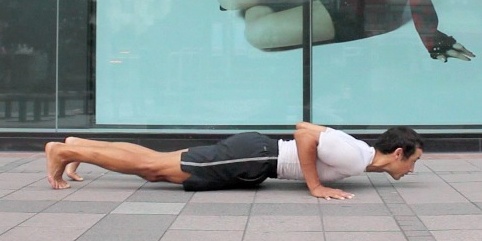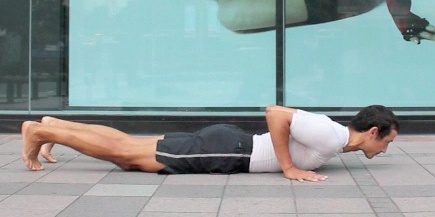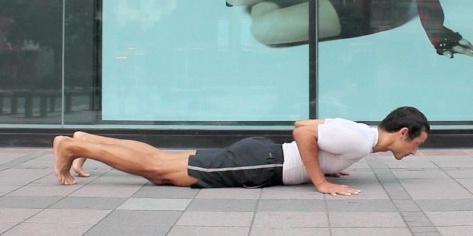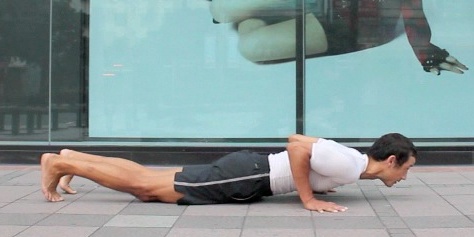Learning Chaturanga Dandasana Intelligently
You Can Be Stronger Than You Think!
In ashtanga yoga, you generally lower down into Chaturanga Dandasana from Plank by bending your elbows. Initially this requires strength but it also requires body awareness and control.
Another way to develop the strength for lowering into chatarunga is to practice lifting up into it. You can develop awareness and muscle control at the same time.
Laying Down But Chest Open
Chest Lifted
Chest and Pelvis Lifted
Chest, Pelvis and Knees Lifted
Laying Down and Lifting Up
Starting on the ground, you can work at using your arms to press your hands down into the ground.
If you push your hands down with enough pressure you can then use your arms to lift your ribcage as if doing a partial chaturanga dandasana. You can then slowly lower it.
You don't have to lift your ribcage alot. Initially, especially if your arm strength is limited, focus on lifting your ribcage high enough that a friend could slide a piece of paper beneath you. Then slowly lower. Once your ribcage is on to the floor gradually relax your arms.
Positioning Your Shoulders and Arms
As you get used to lifting and lowering your ribcage you can focus on positioning your shoulders and arms as you would for a full chaturanga dandasana.
Prior to lifting up you can pull your elbows back. You can use this same action to make the front of your shoulders feel open.
Adding Pelvis and Knees
Once you can comfortably lift your ribcage using your arms, try lifting your ribcage and pelvis off of the floor together. Again it is enough, for now, if your ribcage and pelvis clear the floor.
If you focus on feeling the front of your ribcage and pelvis, you will be able to feel when then leave the floor and when they touch the floor.
Prior to lifting up, you can work at gradually tensing your arm muscles . In the same way you can gradually relax your muscles once your torso is back on the floor again.
Once comfortable with lifting your ribcage and pelvis you can try lifting your knees as well.
The Benefits of Relaxing
Hand Positioning
By the way, position your hands just slightly ahead of your elbows.
You can experiment with having your hands forwards a little bit more or back a little bit more.
Find a position that is comfortable on your shoulders, elbows and wrists.
Read more about it in this article on Chaturanga
Each time you lay down on the ground you have the opportunity to relax. By relaxing you give your body time to recover. You also give yourself a moment to re-focus on what you are about to do. You may find it easier to notice the sensations in your body as you lift up. You can then gradually fine tune your positioning based on what you feel.
As an example, trying to lift up just your ribcage, you may begin to feel how the front of your shoulders cave in when you press up. Or you may notice your elbows flairing out. Once you notice this, you can work at correcting it.
Also, by lifting up and then relaxing, and repeating, the action of your muscles tensing and relaxing helps to pump blood, assisting your heart. You may find that you feel a pleasant "buzz" afterwards.
Lifting Higher and Higher
Once you have the ability to lift your ribcage, pelvis and knees simultaneously, you can practice lifting higher in chaturanga dandasana.
When you lift up, lift high enough that your shoulders are at the same height as your elbows and your chest, pelvis and knees are all off of the floor. Try to inhale and lift up, hold for a breath and then lower while you exhale.
Then work towards lifting all the way into plank (elbows straight.)
As you do so keep your lower back straight or at the very least, decompressed; not bent too much.
Lower all the way to the ground with the same control.
Fine Tuning your Chaturanga Dandasana By Shaping Your Ribcage
Your Intercostals and Your Ribcage
Your intercostals are muscles that lay between the ribs.
They shift the ribs relative to each other either expanding your ribcage, contracting it, twisting it or bending it.
Although the actual movement of each set of ribs individually is quite small, when summed together, their movement as a whole can be great.
Because the shoulders "sit" on top of the ribcage, the way you shape your ribcage when moving into chataranga (either going up into it or dropping into it) can affect the way your shoulders act.
The better you shape your ribcage, and the firmer you make it, the better the foundation your shoulders have from which to act. And your shoulders then in turn provide a platform from which your arms can act to lift your ribcage up.
Once your are comfortable with the above exercises you can modify them.
While laying down with your hands by your sides, lift your shoulders off of the floor and then lower them. Feel your shoulder blades moving as you do so.
Now do the same action with your elbows bend and your hands beneath your elbows, lift your shoulders and then lower. Then keep them lifted.
With your shoulders lifted point your elbows back.
Now to open your chest, lift your head and pull it forwards. Look down as you do so and focus on lenghtening the back of your neck. Open the top of your chest at the same time. Keep your shoulders in the "lifted" position and your elbows pointing back. Press your hands down into the floor and lift your ribs off of the floor. When you are ready add your pelvis and your knees.
Arm Actions
For more on how to use your arms in this yoga pose, read the chaturanga article.
Published: 2011 04 06
Updated: 2020 10 30






